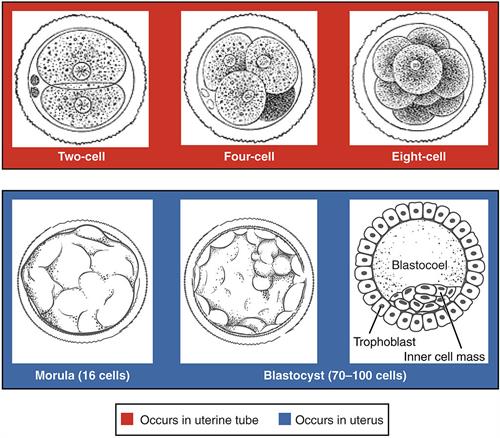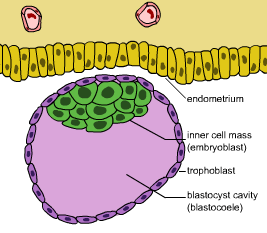
PUMPA - SMART LEARNING
எங்கள் ஆசிரியர்களுடன் 1-ஆன்-1 ஆலோசனை நேரத்தைப் பெறுங்கள். டாப்பர் ஆவதற்கு நாங்கள் பயிற்சி அளிப்போம்
Book Free DemoThe process of development of a single-celled diploid zygote in a newborn until its birth is called embryogenesis.
The process of embryogenesis takes place in four stages, which include:
1. Cleavage and formation of blastula
2. Implantation
3. Gastrulation
4. Organogenesis
Cleavage and Formation of Blastula:
Cleavage is a series of rapid mitotic divisions of the diploid zygote to form a multicellular blastula or blastocyst.
Cleavage, thus, converts the single-celled zygote to a multicellular structure. The first cleavage takes place about \(30\) \(hours\) after fertilisation, where the zygote divides into two cells - blastomeres. The next division takes place within forty \(hours\) after fertilisation.
While the third division takes place for nearly three days after fertilisation. The embryo slowly moves down the fallopian tube towards the uterus, during cleavage. At the end of the fourth day, the embryo reaches the uterus with \(8\) - \(16\) blastomeres, called the morula.
A GIF depicting the developmental stages of an embryo:

Zygote to Morula - The stages of cleavage
At the next stage, the morula rapidly divides, and a multicellular mass comprises \(64\) cells blastomeres is produced.

Developmental stages of the zygote from cleavage to blastocyst formation
The blastomeres rearrange into an outer layer of smaller cells called trophoblast and an inner group of larger cells called inner cell mass. There is also a hollow cavity called blastocyst cavity or blastocoel. The structure containing trophoblast, inner cell mass and blastocyst cavity together is called a blastocyst.

Blastocyst
The following video shows cleavage and blastocyst formation:
After reaching the uterus, the blastocyst is attached and embedded to the endometrium of the uterus.
The process of attachment of the blastocyst to the uterine wall (endometrium) is called implantation.
The blastocyst gets embedded in a pit that is formed in the endometrium. The inner cell mass of the blastocyst gives rise to the embryo. The cells of the trophoblast form the parts of the placenta.
The fertilised egg becomes implanted in about \(6\) to \(7\) days after fertilisation.

Picture depicting the process of cleavage and implantation of a blastula
Reference:
https://upload.wikimedia.org/wikipedia/commons/thumb/e/e4/2903_Preembryonic_Cleavages-02.jpg/1024px-2903_Preembryonic_Cleavages-02.jpg
https://upload.wikimedia.org/wikipedia/commons/f/fd/Blastocyst.png
https://www.flickr.com/photos/44163723@N07/4073861331/